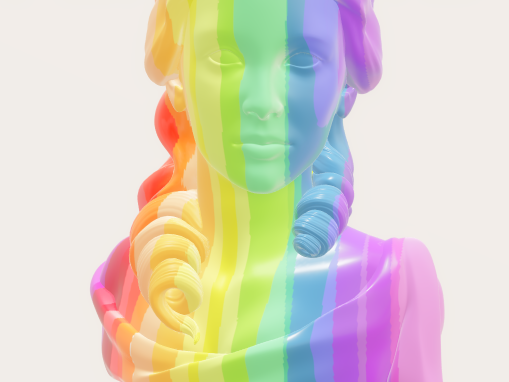Prism Portraits
Laura Okkema, Eric Arthur Murnane, and Rachel Nicole Winter
When we show our faces on social platforms such as Instagram and Snapchat, many of us hide behind a digital photo filter. Jill Walker Rettberg writes as early as 2014 that filters fascinate because they add strangeness to the familiar, showing us “ourselves, or our surroundings, with a machine’s vision” (Rettberg 25-26). The majority of filters offered on social media alter the hue and brightness of an image; for instance, Instagram’s filter “Ludwig” intensifies red tones, while “Aden” adds a purple tint. A 2015 study on the image-sharing platform Pinterest demonstrated that an image’s color impacts how much it is shared (Gilbert and Bahkshi). The authors link this phenomenon to the powerful psychological effect of certain colors on our emotions. For instance, images featuring purple and red are more likely to be shared because they “elicit feelings of arousal.” Applying a hue-based filter may therefore change a viewer’s emotional response to an image. However, filters, as Rettberg notes, have become cliché after endless repetition, and their defamiliarization effect has worn off. Like many other features of digital technology, filters envelop us in the “marvelousness of natural, intuitive, invisible, even ‘magical’ interfaces” (Emerson). We do not often reflect on the nature of filters due to their omnipresence in our digital lives, or the impact they may have on our psyche. Lori Emerson notes that electronic literature has historically disrupted the ideology of invisible interfaces; in a similar vein, we are proposing a project which invites participants to reflect on their filter choices and the ways in which this “machine’s vision” shapes our emotional response to an image. Prism Portraits is a participatory social media archive that challenges the audience to critically re-examine digital photo filters and their effects on our (self-)perception. The project comprises three components: participants’ smartphone cameras, a dedicated hashtag (#prismportraits) and a set of instructions for participants. The instructions will ask participants to take a selfie, select a hue-based filter (either from their preferred social media platform or a photo-editing software), and share the picture on Instagram using #prismportraits. Participants will also be asked to include a rationale explaining their filter choice, answering a set of questions such as: how does this filter change the way your self-perception in this photo? Seeing yourself in this manner, what emotions and thoughts do you experience? Audience members can search the hashtag to view the other Prism Portraits, and are encouraged to express their reactions to the portraits in the comments. Our team will start the conversation by posting our own Prism Portraits in this manner, offering participants a model they can emulate. Over the course of the conference, we hope to create a hashtag-based archive that transforms an individual experience of posting a filtered selfie into a collective one. This offers a unique way for participants to see each other in the virtual space, and we all become creators of a collectively built digital database-artwork. By offering participants the opportunity to creatively engage and reflect on filtered self-(re)presentation in public online spaces, Prism Portraits disrupts the filter-cliché and creates an awareness of the way in which filters shape our emotional responses to images in digital spaces. After the conference, we hope to study the collected data for a research project on the impact of filters on emotion and self-representation.
Bakhshi, Saeideh, and Eric Gilbert. “Red, Purple and Pink: The Colors of Diffusion on Pinterest.” PLoS One, vol. 10, no. 2, 2015. doi: 10.1371/journal.pone.0117148
Emerson, Lori. Reading, Writing, Interfaces. From the Digital to the Bookbound. Minneapolis, MN, University of Minnesota Press, 2008. Kindle Edition.
Walker Rettberg, Jill. Seeing Ourselves through Technology. How We Use Selfies, Blogs and Wearable Devices to See and Shape Ourselves. New York, NY, Palgrave Macmillan, 2014.
About the Artist
Laura Okkema is a German-American independent artist and scholar whose work comprises visual art, electronic literature, and digital media scholarship. As an activist critical maker, Laura uses digital and analog media to tell stories that inspire compassion with marginalized populations. She completed her PhD in Texts and Technology at the University of Central Florida in May 2019. Her scholarship has been published in OneShot: A Journal of Critical Play and Games as well as the Proceedings of Computers and Writing and The Digital Games Research Association.
Rachel Winter is a PhD candidate in the Texts and Technology program at the University of Central Florida. Her scholarly work examines the curation of digital identities via the creation and circulation of user generated content, particularly those related to political or regional communities. She has recently been published in Transformative Works and Cultures and Porn Studies.
Eric Murnane is an Assistant Professor of Games and Interactive Media at the University of Central Florida. His artistic work pushes at the boundaries of re/presentation, examining how the digital changes our perception of self. His scholarship examines the construction of narrative in digital spaces, especially in video games. He has been published in the Proceedings of the Foundations of Digital Games, OneShot: A Journal of Critical Play and Games, the Journal of Popular Culture, and Well Played.
